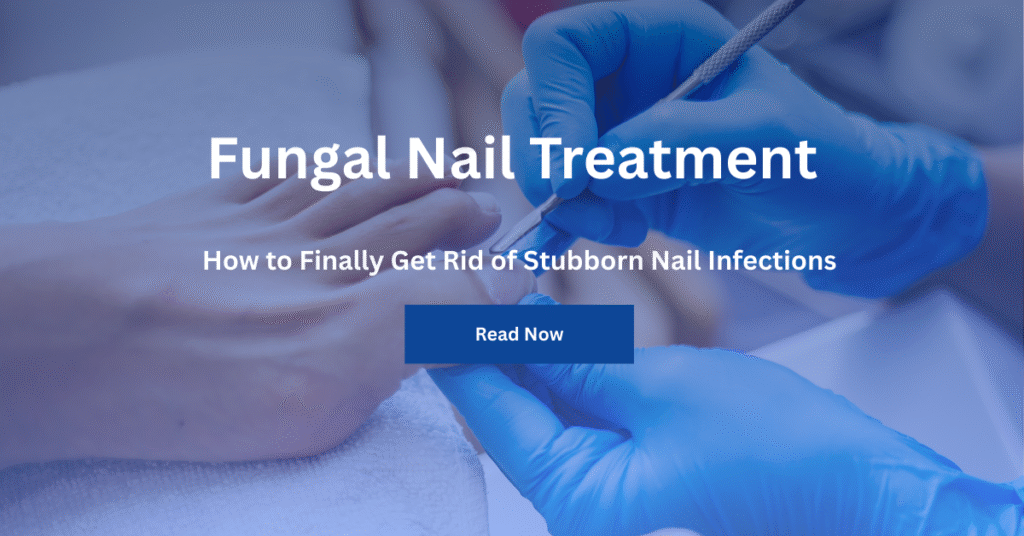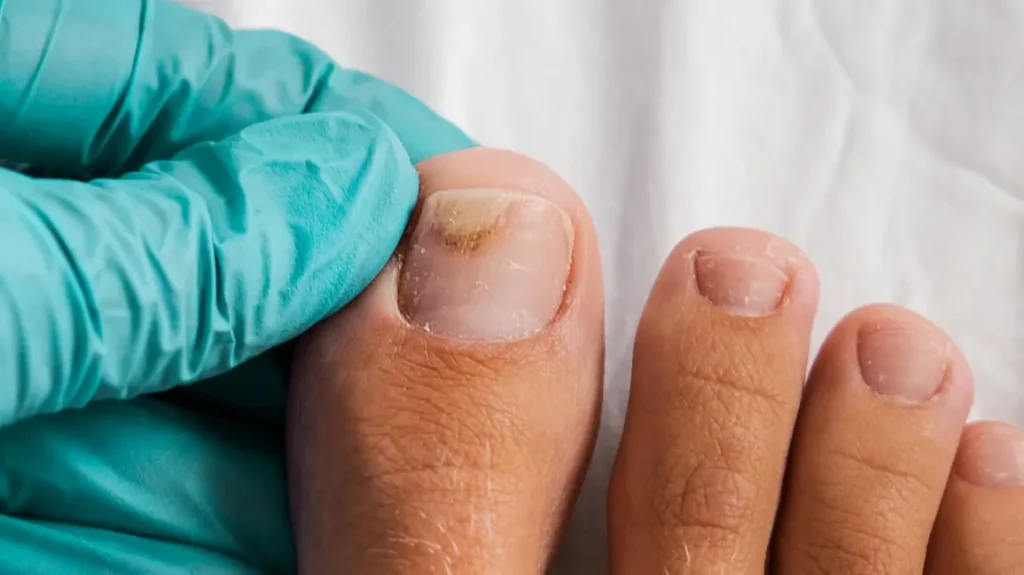
If you’ve ever looked down at your toenails and noticed a yellowish tinge, thickened edges, or a crumbly texture that just won’t go away, chances are you’ve encountered a fungal nail infection. It’s a frustrating condition that can linger for months—sometimes years—if not properly treated.
I know from experience how embarrassing and uncomfortable fungal nails can be. For a long time, I avoided sandals in the summer, and even at the swimming pool I kept my feet hidden. What makes things worse is that fungal nail infections rarely go away on their own. The good news? With the right approach, you can beat them and grow back healthy nails.
In this article, I’ll walk you through everything you need to know about fungal nail treatment—from what causes it, to medical solutions, home remedies, prevention tips, and the timeline you can realistically expect. Read More About The Causes of Fungal Nail Here

What Exactly Is a Fungal Nail Infection?
A fungal nail infection (doctors call it onychomycosis) happens when fungi invade the nail bed. It’s much more common in toenails than fingernails, mostly because our feet spend hours in socks and shoes, which create the warm, damp environment fungi love.
Typical signs include:
Thickened nails that are difficult to trim
Discolouration (yellow, brown, or even white streaks)
Nails that become brittle or crumble at the edges
A slight odour (in some cases)
Pain if the nail presses into the skin or shoe
You can find more information about fungal nail infection on the official NHS page here.
Why Do Fungal Nails Happen in the First Place?
You don’t need poor hygiene to get a fungal nail infection. In fact, many perfectly clean people get them. But certain factors make you more vulnerable:
Wearing tight or non-breathable shoes that trap sweat
Walking barefoot in communal areas like gyms or pools
Having diabetes or circulation problems
Injuring your nail, which lets fungus in
Age (older adults get it more often)
If you’ve ever had athlete’s foot, that can also spread to the toenails if not treated.
The Best Fungal Nail Treatments
Here’s where things get tricky. People often want a “quick cure,” but fungal nails rarely disappear overnight. The nail has to grow out, which takes months. Still, there are effective treatments that actually work.
1. Antifungal Nail Lacquers and Creams
If you catch it early, over-the-counter treatments can help. These include medicated nail polishes containing amorolfine or creams with clotrimazole.
You’ll need to apply them consistently for months.
Filing down the thick nail helps the medicine sink in.
They work best on mild infections affecting the surface or edges.
2. Prescription Tablets
For more stubborn infections, doctors often prescribe terbinafine or itraconazole. These work internally, attacking the fungus from the inside out.
Treatment usually lasts 6–12 weeks.
Side effects can happen (like stomach upset or liver issues), so monitoring may be needed.
These medicines are more effective than topical treatments but not suitable for everyone.
3. Laser Fungal Nail Treatment
Laser therapy is becoming more popular, especially for people who can’t take tablets. A laser heats and kills the fungus in the nail bed.
The treatment is painless and quick.
You may need several sessions.
It can be expensive and isn’t always available on the NHS, but private clinics offer it.
- you can find laser fungal nail Treatment at Revitalise london dermatolgy clinic
4. Natural and Home Remedies
Now, this is where personal experience often comes in. Lots of people—including me—try natural remedies first. Do they work? Sometimes.
Popular options include:
Tea tree oil – antifungal properties, applied daily.
Apple cider vinegar soaks – can change the pH environment.
Vicks VapoRub – surprisingly effective for some, thanks to thymol.
These are usually more supportive than curative. They may help in very mild cases or alongside medical treatment, but don’t expect miracles if your nail is already badly damaged.
5. Nail Removal (Extreme Cases)
If the nail is extremely thick, painful, or resistant, a doctor might remove it. This can be done surgically or using a medicated paste. A new nail then grows back over several months. While it sounds drastic, it’s sometimes the only option.
How Long Fungal Nail Does Treatment Take?
This is the part most people underestimate. Even after killing the fungus, you won’t see a clear nail instantly because nails grow slowly.
Toenails: 6–12 months for a full healthy nail to regrow.
Fingernails: 4–6 months.
If you’ve been treating your nail for a few weeks and don’t see change yet, don’t give up. The improvement shows as the new nail grows in
Preventing Fungal Nail Infections
Prevention is just as important as treatment—because fungal infections love to come back. Here are some habits that make a difference:
Keep feet dry, especially between toes.
Change socks daily. Use cotton or moisture-wicking fabrics.
Wear flip-flops in communal showers or changing rooms.
Trim nails straight across and file thickened edges.
Disinfect shoes with antifungal sprays or powders.
Don’t share nail clippers or shoes.
Living With Fungal Nails: The Emotional Side

Beyond the physical symptoms, fungal nails can really affect confidence. I remember not wanting to get a pedicure or go to the beach because I didn’t want anyone to see my nails. Many people silently struggle with the same feelings.
The important thing to know is: you’re not alone, and it is treatable. With the right plan, patience, and consistency, you can get your nails back to looking and feeling healthy.
FAQs About Fungal Nail Treatment
What is the fastest way to get rid of toenail fungus?
Prescription tablets like terbinafine are usually the fastest medical option. Laser treatment can also speed up results.
Can I treat toenail fungus at home naturally?
Yes, mild cases sometimes improve with remedies like tea tree oil or vinegar soaks, but stronger infections usually need medical treatment.
How can I tell if my nail is fungal or just damaged?
Fungal nails are often thick, yellow, brittle, and sometimes smelly. Trauma-related nail damage typically grows out on its own. A doctor can confirm with a test.
Does toenail fungus go away without treatment?
No. In most cases, fungal infections get worse if ignored.
Are fungal nails contagious?
Yes. Fungus spreads through shared surfaces, towels, socks, or even nail tools.
How do I stop toenail fungus from coming back?
Stick to good foot hygiene, wear breathable shoes, disinfect footwear, and trim nails correctly.
What’s the best over-the-counter fungal nail treatment?
Antifungal lacquers like amorolfine are a good starting point for mild infections.
Final Thoughts
Fungal nail infections aren’t dangerous, but they are persistent and often frustrating. The key to success is choosing the right treatment for your situation—and sticking with it. Whether you go with over-the-counter remedies, prescription tablets, or modern laser therapy, patience is non-negotiable.
Your nails will take time to grow out, but with consistency and good prevention habits, you can restore healthy, clear nails. And perhaps just as importantly—you can step into your sandals with confidence again.

